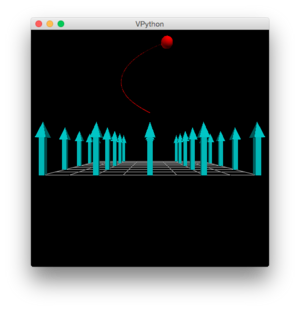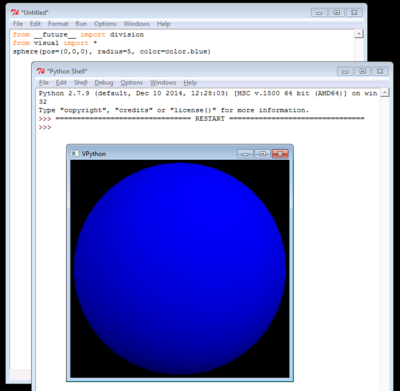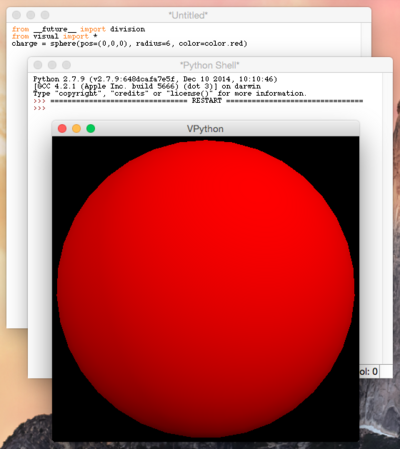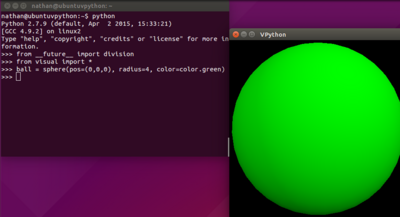VPython: Difference between revisions
(Link to VPython Basics page) |
(Added 'claimed by' banner) |
||
| Line 1: | Line 1: | ||
Claimed by Nathan Cheek | |||
VPython is a Python graphics module used for modeling objects in 3-dimensional space. In the field of physics, this is especially useful for calculating and modeling complex relationships between objects and their properties. | VPython is a Python graphics module used for modeling objects in 3-dimensional space. In the field of physics, this is especially useful for calculating and modeling complex relationships between objects and their properties. | ||
Revision as of 17:54, 2 December 2015
Claimed by Nathan Cheek
VPython is a Python graphics module used for modeling objects in 3-dimensional space. In the field of physics, this is especially useful for calculating and modeling complex relationships between objects and their properties.
Installation
VPython is compatible with Windows, OSX, and Linux. While there is an older VPython version available that supports Python 3, the Georgia Tech physics courses use Python 2 syntax so it is recommended to install the latest version of VPython as outlined below.
Windows
1. Install Python-2.7.
2. Download and install VPython from Sourceforge.
To troubleshoot any installation issues, look at the extensive VPython Windows installation guide.
OSX
1. Install Python-2.7. This is required as the version of Python that Apple provides is not compatible.
2. Download and install the VPython package from Sourceforge.
To troubleshoot installation issues, see the extensive VPython Mac installation guide.
Linux
Some Linux distributions include VPython in their repositories. For example, to install VPython in Ubuntu 15.04:
sudo apt-get install python-visual
If your Linux distribution's repository does not have the latest version of VPython, you can run the Windows version using Wine. The VPython Linux installation guide contains instructions.
Getting started with Python
Introduction to basic Python use
Creating VPython Objects
- Sphere
- Arrow
- Updating objects
Useful built-in functions
Vectors
- cross(vectorA, vectorB)
- mag(vector)
Connectedness
- How is this topic connected to something that you are interested in?
- How is it connected to your major?
- Is there an interesting industrial application?
History
Put this idea in historical context. Give the reader the Who, What, When, Where, and Why.
VPython was originally released in 2000 by David Scherer after he took an introductory physics class at Carnegie Mellon University. At the time, the school used the cT programming language for 2D modeling, and David saw the need for something better. Working with several people including professors Ruth Chabay and Bruce Sherwood, he developed a Python module called Visual. Visual Python or VPython featured 3D modeling, as well as an easier-to-understand object-oriented syntax. VPython is released under an Open Source license, and development continues today.
See also
Are there related topics or categories in this wiki resource for the curious reader to explore? How does this topic fit into that context?
See the VPython Basics wiki page for getting started with Python programming.
Further reading
Books, Articles or other print media on this topic
External links
Internet resources on this topic
References
This section contains the the references you used while writing this page



